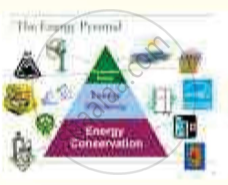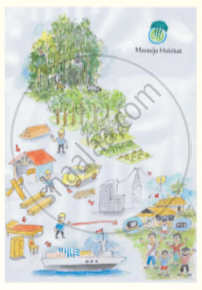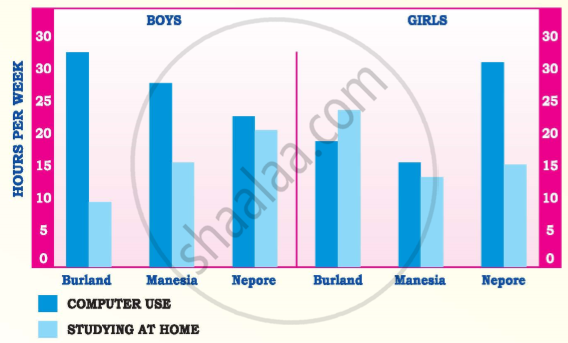Advertisements
Advertisements
प्रश्न
“Living conditions have been improving….”
Key
——- Number of children in secondary school.
——- Number of people dying from malnutrition.
——- Number of homes with running water.
——- Number of women working outside the home.
Write a report on the changes in living conditions in Medland between 1950 and now. Suggest reasons for these changes. Use the present perfect continuous where necessary. You may wish to use the words in the vertical box above right.
(b) The number of homes with running water has been rising sharply since 1985, whereas
उत्तर
Over the years since 1950 the number of children in secondary schools has been increasing noticeably. This is possibly because the Government has been building more schools to provide the education at secondary level. The efforts of the Government in providing health education, a meal a day to the children at schools, sanitary conditions and facilities in hospi¬tals and Primary Health Centres, have borne fruits. The people have become health conscious. That is why, there has been a noticeable fall in the number of children and people dying from malnutrition.
The number of homes with running water has been rising sharply since 1985. A large number of people have been getting clean and pure water. This has sharply decreased the cases of water-borne diseases. The number of women working outside homes has been steadily increasing boosting their husbands’ income and rise in their standard of living.
APPEARS IN
संबंधित प्रश्न
Answer the following question briefly
Which of the following traits are relevant to the character of the narrator's grandmother?
(i) determined
(ii) selfish
(iii) emotional
(iv)mean
Give reasons for your choice.
On the basis of your understanding of the poem, answer the following question
by ticking the correct choice.
The tone of the speaker in the first stanza is that of ______________.
The poet could not understand the words of the song, yet he raised several
possibilities about its theme. In the chart below are some of these possibilities.
Read the third stanza again, and find the phrase that matches each. Complete the
chart, by writing a phrase in each of the empty boxes. Work in pairs.

On the basis of your understanding of the poem, answer the following question
by ticking the correct choice.
All 'have their exits and their entrances'. Exits and entrances refer to __________.
On the basis of your reading of the poem, complete the following table.
| Stages in the life of the poet | Activities | Consequences |
| Youth | eating toffees ____________ |
____________ |
| Adulthood | ____________ | gazing at the dentist in despair. |
Comparing Quantities
Study the following graph depicting major exports from Medland in the
current year.

Write a short report on major exports from Medland this year compared with the last year. Use words from the box above. Divide your report into two paragraphs as indicated:
Medland’s Export Trends
On the whole, Medland exported slightly less this year than the last year. Concerning foodstuffs,
_________________________________________________________________
As regards non-edible goods,_____________________________________________
In groups, work on one of the topics mentioned in 8(a)-(g). Research your topic by collecting relevant articles from the print and electronic media (like the National Geographic). Make a power point presentation of 10-12 minutes. You can also use film clippings to enrich your presentation.
(a) SOLAR MISSION
1) To promote the use of solar energy through solar photovoltaic and thermal systems for power generation .
2) To integrate other renewable energy technologies like biomass and wind. 
(b) ENERGY EFFICIENCY
1) To mitigate GHG through sector-specific and cross-cutting technology and fuel switch options.
2) To use more LNG and biomass fuels besides seeking tech transfer. 
(c) SUSTAINABLE HABITAT
1) To promote energy efficiency in the residential and commercial sectors through LPG use.
2) To manage municipal solid waste and urban public transport in a better way. 
(d) WATER MISSION
1) To promote efficient water use, augment supply in critical areas and ensure effective management of water resources.
2) To have better management of surface and groundwater,and conserve wetlands. 
(e) SUSTAINING HIMALAYAS
1) To enhance monitoring and conservation of the Himalayan ecosystems, empower local communities for management of ecological resources and promote sustainable tourism. 
(f) GREEN INDIA
1) To reduce fragmentation of forests, enhance public and private investments for plantation, upscale joint forestry management and promote conservation of biodiversity. Need to afforest degraded lands.

(g) SUSTAINABLE AGRICULTURE :
1) To focus on four crucial areas - dry land agriculture, risk management, access to information and promoting the use of biotechnology.
2) To develop drought and pest resistant varieties. 
Rearrange the following to form meaningful sentences. The first one has been done as an example. Write the answers against the correct numbers.
Put into / as the / at low / baby can / he is / as soon / water / toddle / tide
As soon as the baby can toddle he is put into water at low tide.
(a) water / the baby / in the/ there / plays/ sits and
(b) long enough / the mother / him/ does not / to worry / there / leave him
(c) older / at low tide / as / wade about / allowed to / he is / he grows
(d) look out / water / keep a / into deep / sharp / does not stray / so that he/ his elders
(e) permitted to / from which / judgment / he may / make small mistakes / he is / learn to make better
(f) are given / to swim / small canoes / the children / they / own / are able/ of their / when
What comes next
Connectors are indicators or markers of what comes next in a text.
Look at these extracts from longer texts. Decide which marker/connector could be used in the blanks to indicate what comes next. e.g.
There are many good players in the cricket team: for instance, Tendulkar and Dhoni.
- There are two main types of elephant in the world: ___________ , the Indian and the African.
- He is good at swimming, tennis and hockey. ___________, he has also represented the school in cricket.
- Many environmentalists strongly object to the mill being built at Srutipur, ___________ the unemployed are very happy at the proposal.
- Her performance in the Olympics did not match our expectations. ___________, she hasn’t improved much in the recent past.
- In the field of research the computer, has proved immensely useful. ___________, it has become an indispensable tool for all kinds of scientific endeavour
- The import of petrol has been banned in the Midlands. ___________, the price of it has gone up.
Study the following graph and the accompanying report.

Our study of the time spent by students at the computer and studying at home in three countries has revealed some interesting facts.
First, the majority of boys and girls in the age groups of 14-16 in these countries spend more time at the computer than studying at home. Children in these countries spend an average of20-30 hours per week in comparison to 10-15 hours of studying at home. The only exception is Burland where girls spend more time studying at home than at the computer.
Secondly it is evident that in all three countries, time spent at the computer is having a serious impact on the number of hours spent studying at home. In fact, the greater the number of hours spent at the computer, the fewer number of hours are being spent studying. For example, boys in Burland spend an average of 32 hours at the computer while they spend about 8 hours studying at home.
